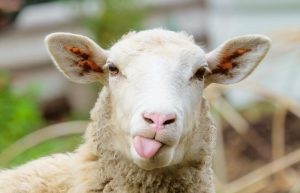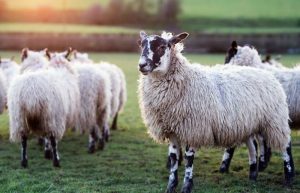
What You Need to Know About Bathing Sheep
Sheep are commonly recognized for their thick and fluffy wool coats, which can be shorn and sold to make wool products like yarn, clothing, and blankets. Wool is often considered to be a valuable fabric that’s in high demand. If you have sheep and plan on selling their wool, you may be wondering how bathing could affect their coats.
Can you bathe sheep? You can bathe sheep to get them clean, treat skin conditions, and practice good hygiene. Wool sheep have a water-proof grease called lanolin that covers their coats, so you’ll need to use a de-greasing shampoo to effectively clean the sheep. You’ll also need to blow dry wool sheep as their wool can trap moisture to the skin and prevent the sheep from thoroughly drying.
Knowing how to properly bathe and clean your sheep is an important part of caring for your flock’s health. As livestock living primarily outdoors, sheep can get quite dirty. To learn more about how to bathe a sheep, keep reading!
How to Bathe a Sheep: Step-By-Step Guide
You can follow the same steps to bathe either a hair sheep or a sheep that has thick wool fleece; however, there are certain things mentioned in the below points that you will need to be aware of as you bathe a sheep with wool. Follow these steps to bathe your sheep:
Step #1: Wet the Sheep From Head to Tail
To bathe your sheep, start by rinsing the sheep’s body from head to toe. As you wet around their head and neck, be sure to gently pinch the sheep’s ears closed to avoid getting water in them. Getting water in your sheep’s ear can cause them discomfort and can even lead to infection.
Wool sheep fleece is made waterproof by grease that sheep naturally produce called lanolin. The lanolin coats the wool and can initially make it difficult to get your wool sheep wet. You may have to use your hand to work the water down into their coat.
As you rinse your sheep with water, sometimes the water will be enough to remove dirt and mud. Pay special attention to the sheep’s legs, stomach, and backside, as these are the areas that tend to be the dirtiest.
Step #2: Work Dish Soap or Degreasing Shampoo Into the Sheep’s Coat
To clean your wool sheep, you can use dish soap or degreasing shampoo. Dish soap has degreasing properties and will work just as well as any sheep shampoo you can find. The reason you want to use a degreasing agent on your sheep is to break down the water-proof lanolin grease that covers the sheep’s wool fleece. This will enable you to thoroughly clean the coat of your sheep. You can also use dish soap on hair sheep, as it is just as effective at getting them clean.
Use your hands to work the shampoo into the sheep’s wool and over their skin. While you’re most likely bathing your sheep to clean their fleece or coat, it’s also important to clean their skin in the process.
Your sheep’s skin can go largely overlooked since they may be covered with a thick fleece; however, rain rot and bacterial infections will directly affect their skin. This is especially common in wool sheep where the wool will trap moisture against the sheep’s skin. The cleaner you can keep their skin, the less likely they will be to deal with bacterial or fungal infections. You can work the shampoo over the sheep’s skin by using your fingertips.
Step #3: Thoroughly Rinse Shampoo Off of the Sheep
Next, you’ll want to rinse the shampoo or dish soap from your sheep. You can hold the nozzle of your nose close to the sheep’s wool to help flush the shampoo out from under the wool. With hair sheep, you can run your hands over the sheep to help remove shampoo from the body.
Shampoo left in the hair or on the skin can cause the sheep’s coat and skin to dry out and become flaky. A good rule of thumb is to keep rinsing the sheep until shampoo suds stop gathering at their feet. Also, remember to block the ears again as you rinse around the sheep’s head and neck.
Step #4: Remove Excess Water From the Sheep’s Coat
Once you have thoroughly rinsed your sheep and removed all shampoo or dish soap, you’ll want to remove excess water from your sheep’s body. Excess water in their coats and on their skin can make it difficult for the sheep to regulate their body temperature, especially for wool sheep since their fleece will trap the moisture to the sheep’s skin.
For hair sheep, you can use a water squeegee to flick off the excess dripping water. From there, hair sheep will air-dry quickly. For wool sheep, you’ll need to use a shop vac or a blower to dry them off completely before turning them back out.
Why Bathe a Sheep?
 Now that you know how to bathe a sheep, it’s time to know why you should bathe your sheep every now and then. Sheep are relatively low maintenance, so it can be easy to overlook some of their basic needs every now and then. Here are some reasons why you should bathe a sheep:
Now that you know how to bathe a sheep, it’s time to know why you should bathe your sheep every now and then. Sheep are relatively low maintenance, so it can be easy to overlook some of their basic needs every now and then. Here are some reasons why you should bathe a sheep:
Bathe a Sheep to Remove Dirt and Clean Their Fleece
Rarely do you look in a pasture to see a clean livestock animal. Since sheep usually live outside 24/7, they can get quite dirty, especially in the wet months when the pasture is muddy. Wool sheep are usually the worst since dirt and mud can get trapped in their thick fleece.
If you plan on showing sheep and being in 4H, you may find yourself bathing sheep quite a bit. When it comes to selling your sheep, you want it to look its best. You can follow the same steps above to get your sheep ready for a show; however, there are products like whitening shampoo and conditioner that can help your sheep stand out.
Bathe a Sheep to Make it Easier to Shear
Shearing is an anticipated process that takes place one to two times a year. Shearing is when you shave the wool fleece off of your sheep, whether you plan on selling the fleece for profit or simply practicing good hygiene for your sheep. This usually takes place in the springtime so the sheep will be ready for summer.
It is notoriously difficult to shear or clip any animal that has a dirty coat. When the razor hits dirt clumps, it can uncomfortably tug at the animal’s hair. This is just one reason you should consider bathing your sheep before shearing.
While wool is usually sent to a factory where it is professionally cleaned and prepared for commercial markets, many people can’t stand the idea of selling off dirty wool, even if it is right off the sheep. This is another reason you may bathe a sheep before shearing.
Bathe a Sheep to Treat Skin Conditions
Because of their thick fleeces, you may never know that your sheep is suffering from a skin condition. One of the most common skin conditions sheep deal with is Dermatophilosis (also known as rain rot) and Sheep scab. Dermatophilosis is a bacterial skin infection that occurs most often when moisture is held to the sheep’s skin for too long. This condition also affects horses, goats, and cows.
Sheep scab is caused by a mite that gets into the sheep’s skin and causes them to deal with irritated and itchy skin. Sheep can also be infested by fleas, which rely on the host’s blood to survive. All of these conditions can be spread from sheep to sheep, but will largely go undetected.
Treating conditions in your sheep may require you to shear them to treatments that may be more effective. Treating skin conditions usually requires bathing your sheep with a medicated shampoo that will kill bacteria and ban parasites.
Sheep can be treated for fleas much like goats can. You can learn more by reading my article Do Goats Get Fleas: Essential Goat Care.
Bathe a Sheep For Hygiene Purposes
You can also bathe your sheep for hygiene purposes. By taking sanitary measures, you can keep your flock more healthy overall. While livestock are constantly in the dirt, mud, and poop, working to provide a clean and sanitary lifestyle can go a long way in providing quality of life for your sheep.
The biggest example of this is bathing your ewes to help them prepare for birthing time. A few weeks before the ewes are due, you can bathe your sheep and shear their backsides and around their udders. This will help keep the sheep cleaner during birth and will also allow newborn lambs to nurse more easily.
Who doesn’t love sheep? We have many articles dedicated to helping you take good care of your sheep. Check out the articles down below!
- Why Sheep Bleat: Essential Behavior Guide
- Can You Keep a Sheep By Itself? Essential Guide
- Leaving Sheep Out in the Rain: Everything You Need to Know
